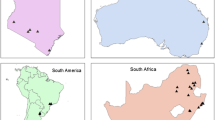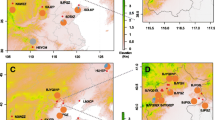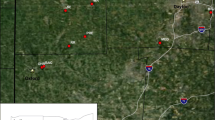Abstract
Biological invasions represent a major threat to agriculture and forestry across the globe. Thaumastocoris peregrinus is a small sap-sucking heteropteran bug that has recently invaded a number of eucalypt plantations worldwide from its native range in Australia. To date, no studies have examined the range of this insect within Australia, and its population genetics remain poorly understood. We sampled T. peregrinus from 16 populations from South East Queensland, across New South Wales (NSW) and Victoria to south-eastern South Australia, and generated microsatellite and mtDNA data for ~ 200 individuals. Population genetic analyses consistently revealed moderate levels of genetic isolation by distance among populations across the range. Nonetheless, T. peregrinus has undergone dispersal across large distances, as revealed by the presence of identical mitochondrial haplotypes in both South East Queensland and South Australia. Two populations within the Sydney area (NSW) were divergent from other populations based on STRUCTURE and factorial correspondence analysis. They also had relatively low allelic richness and haplotype diversity indices. These results suggest they are the result of a relatively recent invasion event, consistent with their discovery in 2001. Pairwise genetic distance analyses suggest that the source of the invasion may have been central NSW. Our study provides an important framework for understanding the biology of this pest in its native environment, and may have implications for determining how it has invaded multiple areas worldwide.






Similar content being viewed by others
References
Brockerhoff EG, Bain J, Kimberley M, Knížek M (2006) Interception frequency of exotic bark and ambrosia beetles (Coleoptera: Scolytinae) and relationship with establishment in New Zealand and worldwide. Can J For Res 36:289–298
Carpintero DL, Dellapé PM (2006) A new species of Thaumastocoris Kirkaldy from Argentina (Heteroptera: Thaumastocoridae: Thaumastocorinae). Zootaxa 1228:61–68
Cassis G, Schuh RT, Brailovsky H (1999) A review of Onymocoris (Heteroptera: Thaumastocoridae), with a new species, and notes on hosts and distributions of other thaumastocorid species. Acta Soc Zool Bohem 63:19–36
Chapman JW, Nesbit RL, Burgin LE, Reynolds DR, Smith AD, Middleton DR, Hill JK (2010) Flight orientation behaviors promote optimal migration trajectories in high-flying insects. Science 327:682–685
Chapuis MP, Estoup A (2007) Microsatellite null alleles and estimation of population differentiation. Mol Biol Evol 24:621–631
Csilléry K, Blum MGB, Gaggiotti OE, François O (2010) Approximate Bayesian Computation (ABC) in practice. Trends Ecol Evol 25:410–418
Dabrowski M, Bornelöv S, Kruczyk M, Baltzer N, Komorowski J (2015) ‘True’ null allele detection in microsatellite loci: a comparison of methods, assessment of difficulties and survey of possible improvements. Mol Ecol Res 15:477–488
Drake VA, Farrow RA (1988) The influence of atmospheric structure and motions on insect migration. Ann Rev Entomol 33:183–210
Drake CJ, Slater JA (1957) The phylogeny and systematics of the family Thaumastocoridae (Hemiptera: Heteroptera). Ann Entomol Soc Am 50:353–370
Estoup A, Guillemaud T (2010) Reconstructing routes of invasion using genetic data: why, how and so what? Mol Ecol 19:4113–4130
Evanno G, Regnaut S, Goudet J (2005) Detecting the number of clusters of individuals using the software STRUCTURE: a simulation study. Mol Ecol 14:2611–2620
Goudet J, Perrin N, Waser P (2002) Tests for sex-biased dispersal using bi-parentally inherited genetic markers. Mol Ecol 11:1103–1114
Gray KA, Noack AE, Johnson RN, Eldridge MDB, Bess EC, Lo N, Rose HA (2010) Eleven di-nucleotide polymorphic microsatellite markers for the winter bronzing bug Thaumastocoris peregrinus Carpintero and Dellapé (Heteroptera: Thaumastocoridae) Mol. Ecol Res 10:1106–1108
Hodel DR, Arakelian G, Ohara LM (2016) The Bronze Bug: another new threat to eucalypts in California. Palm Arbor 5:1–11
Huelsenbeck JP, Ronquist F (2001) MRBAYES: bayesian inference of phylogenetic trees. Bioinformatics 17:754–755
Hulme PE (2009) Trade, transport and trouble: managing invasive species pathways in an era of globalization. J Appl Ecol 46:10–18
Hurley BP, Garnas J, Wingfield MJ, Branco M, Richardson DM, Slippers B (2016) Increasing numbers and intercontinental spread of invasive insects on eucalypts. Biol Invasions 18:921–933
Hutchison DW, Templeton AR (1999) Correlation of pairwise genetic and geographic distance measures: inferring the relative influences of gene flow and drift on the distribution of genetic variability. Evolution 53:1898–1914
Jiménez-Quiroz E, Vanegas-Rico JM, Morales-Martínez O, Lomeli-Flores JR, Rodríguez-Leyva E (2016) First Record of the Bronze Bug, Thaumastocoris peregrinus Carpintero and Dellapé 2006 (Hemiptera: Thaumastocoridae), in Mexico. J Agric Urban Entomol 32:35–39
Johnson MS, Black R (1984) The Wahlund effect and the geographical scale of variation in the intertidal limpet Siphonaria sp. Mar Biol 79:295–302
Keane RM, Crawley MJ (2002) Exotic plant invasions and the enemy release hypothesis. Trends Ecol Evol 17:164–170
Leigh JW, Bryant D (2015) popart: full-feature software for haplotype network construction. Methods Ecol Evol 6:1110–1116
Librado P, Rozas Z (2009) DnaSP v5: a software for comprehensive analysis of DNA polymorphism data. Bioinformatics 25:1451–1452
Miller MP (2005) Alleles In Space (AIS): computer software for the joint analysis of interindividual spatial and genetic information. J Hered 96:722–724
Mutitu EK, Garnas JR, Hurley BP, Wingfield MJ, Harney M, Bush SJ, Slippers B (2013) Biology and rearing of Cleruchoides noackae (Hymenoptera: Mymaridae), an egg parasitoid for the biological control of Thaumastocoris peregrinus (Hemiptera: Thaumastocoridae). J Econ Entomol 106:1979–1985
Nadel RL, Noack AE (2012) Current understanding of the biology of Thaumastocoris peregrinus in the quest for a management strategy. Int J Pest Manag 58:257–266
Nadel RL, Slippers B, Scholes MC, Lawson SA, Noack AE, Wilcken CF, Bouvet JP, Wingfield MJ (2009) DNA bar-coding reveals source and patterns of Thaumastocoris peregrinus invasions in South Africa and South America. Biol Invasions 12:1067–1077
Noack AE (2002) Thaumastocoridae: an investigation. http://pandora.nla.gov.au/pan/32881/20030204/www.thaumastocoridae.org/index.html. Accessed 8 July 2011
Noack AE (2009) The taxonomic revision of the genus Thaumastocoris and the biology and chemical control of the eucalypt pest Thaumastocoris peregrinus (Heteroptera: Thaumastocoridae). Ph.D. thesis, The University of Sydney
Noack AE, Rose HA (2007) Life-history of Thaumastocoris peregrinus and Thaumastocoris sp. in the laboratory with some observations on behaviour. Gen Appl Entomol 36:27–33
Noack AE, Kaapro J, Bartimote-Aufflick K, Mansfield S, Rose HR (2009) Efficacy of imidacloprid in the control of Thaumastocoris peregrinus on Eucalyptus scoparia in Sydney, Australia. Arboricult Urb For 35:192–196
Noack AE, Cassis G, Rose HA (2011) Systematic revision of Thaumastocoris Kirkaldy (Hemiptera: Heteroptera: Thaumastocoridae). Zootaxa 3121:1–60
Novoselsky T, Freidberg A (2016) First record of Thaumastocoris peregrinus (Hemiptera: Thaumastocoridae) in the Middle East, with biological notes on its relations with eucalyptus trees. Isr J Entomol 46:43–55
Orantes LC, Zhang W, Mian MAR, Michel AP (2012) Maintaining genetic diversity and population panmixia through dispersal and not gene flow in a holocyclic heteroecious aphid species. Heredity 109:127–134
Paine TD, Steinbauer MJ, Lawson SA (2011) Native and exotic pests of Eucalyptus: a worldwide perspective. Annu Rev Entomol 56:181–201
Peakall R, Smouse PE (2012) GenAlEx 6.5: genetic analysis in Excel. Population genetic software for teaching and research—an update. Bioinformatics 28:2537–2539
Pimentel D, McNair S, Janecka J, Wightman J, Simmonds C, O’Connell C, Wong E, Russel L, Zern J, Aquino T, Tsomondo T (2001) Economic and environmental threats of alien plant, animal, and microbe invasions. Agric Ecosyst Environ 84:1–20
Pritchard JK, Stephens M, Donnelly P (2000) Inference of population structure using multilocus genotype data. Genetics 155:945–959
Rejmánek M, Richardson DM (2011) Eucalypts. In: Simberloff D, Rejmánek M (eds) Encyclopedia of biological invasions. University of California Press, Los Angeles, pp 203–209
Saavedra MC, Avila GA, Withers TM, Holwell GI (2015) The potential global distribution of the Bronze bug Thaumastocoris peregrinus Carpintero and Dellapé (Hemiptera: Thaumastocoridae). Agric For Entomol 17:375–388
Santadino M, Brentassi ME, Fanello DD, Coviella C (2017) First evidence of Thaumastocoris peregrinus (Heteroptera: Thaumastocoridae) feeding from mesophyll of eucalyptus leaves. Environ Entomol 46:251–257
Soliman EP, Wilcken CF, Pereira JM, Dias TKR, Zaché B, Dal Pogetto MHFA, Barbosa LR (2012) Biology of Thaumastocoris peregrinus in different eucalyptus species and hybrids. Phytoparasitica 40:223–230
Tamura K, Stecher G, Peterson D, Filipski A, Kumar S (2013) MEGA6: molecular evolutionary genetics analysis, version 6.0. Mol Biol Evol 30:2725–2729
Wilcken CF, Soliman EP, Nogueira de Sá LA, Barbosa LR, Dias TKR, Ferreira-Filho PJ, Oliveir RJR (2010) Bronze bug Thaumastocoris peregrinus Carpintero and Dellapé (Hemiptera: Thaumastocoridae) on eucalyptus in Brazil and its distribution. J Plant Protect Res 50:201–205
Wingfield MJ, Slippers B, Hurley BP, Coutinho TA, Wingfield BD, Roux J (2008) Eucalypt pests and diseases: growing threats to plantation productivity. South For 70:139–144
Zhang Y, Wang L, Wu K, Wyckhuys KA, Heimpel GE (2008) Flight performance of the soybean aphid, Aphis glycines (Hemiptera: Aphididae) under different temperature and humidity regimens. Environ Entomol 37:301–306
Acknowledgements
The authors wish to thank Michael Brown for his generous financial assistance, which allowed the collections to take place, and Cleo Gardiner for helping with the collections.
Author information
Authors and Affiliations
Corresponding author
Additional information
Communicated by B. Hurley.
Special Issue: “Invasive Pests of Forests and Urban Trees”.
Electronic supplementary material
Below is the link to the electronic supplementary material.
Rights and permissions
About this article
Cite this article
Lo, N., Montagu, A., Noack, A. et al. Population genetics of the Australian eucalypt pest Thaumastocoris peregrinus: evidence for a recent invasion of Sydney. J Pest Sci 92, 201–212 (2019). https://doi.org/10.1007/s10340-018-0995-8
Received:
Revised:
Accepted:
Published:
Issue Date:
DOI: https://doi.org/10.1007/s10340-018-0995-8




